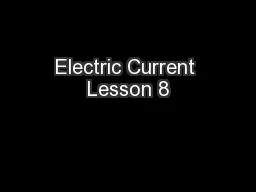

December 9 th 2011 Electric Current is the measure of the rate of electron flow past a given point in a circuit measured in amperes A Think of it in terms of a waterfall If you could count the number of water molecules that drop over the edge every second you could get the rate at ID: 702490
Download Presentation The PPT/PDF document "Electric Current Lesson 8" is the property of its rightful owner. Permission is granted to download and print the materials on this web site for personal, non-commercial use only, and to display it on your personal computer provided you do not modify the materials and that you retain all copyright notices contained in the materials. By downloading content from our website, you accept the terms of this agreement.
Slide1
Electric Current
Lesson 8
December 9
th
, 2011Slide2
Electric Current is the measure of the
rate of electron flow past a given point in a circuit
; measured in amperes (A). Slide3
Think of it in terms of a waterfall. If you could count the number of water molecules that drop over the edge every second, you could get the rate at which water is flowing past a particular point.
Now think of the water molecules as electrons in a wire running past a particular point in a specific amount of time and you have the concept of current. Slide4
Measuring Current
Current in a circuit is measured using an
ammeter
.
The unit of electric current is the
ampere (A
). An ampere is a measure of the amount of charge moving past a point in the circuit every second.Slide5
One ampere of charge in a circuit means that
6.2 x 10
18
electrons pass a particular point every second. Slide6
When you connect an ammeter or voltmeter to a circuit, they must be on the right terminals.
-There are two terminals on a meter that you use to connect to a circuit.
The negative (–) terminal is often
black
,
The positive (+) terminal is often
red
.Slide7
Always connect the positive terminal of the meter to the positive terminal of the electrical source.
Connect the negative terminal of the meter to the negative terminal of the electrical source.Slide8
Calculating Current
I
Q
tSlide9
Rearranging formulas
- The magic triangle
I
Q
t
I
Q
t
Therefore, Amperes = Coulombs / sSlide10
Quantity
Symbol
Units of measurement
Charge
Q
C (coulomb)
Current
I
A (amperes) amps
Time
t
s (seconds)Slide11
GRASP Method to solving Problems
G –
Given
- Write down the values that are given to you in the problem
R –
Required
– Write down the value that you are trying to find. A - Analyze
– Write down the formula that you are going to use
S –
Solve
– Substitute the given values into the formula
P –
Paraphrase
– A statement that answers the questionSlide12
Example 1
If 310 C of charge passes a point in a conductor in 10 minutes, what is the current through that point in the conductor?
Given
Charge = Q = 310 C
Time =
Solve
=
0.52 A
Required
Current = ?
Paraphrase
Therefore, the current is 0.52 amperes.
AnalysisSlide13
Example 2
A 6.5 amp vacuum cleaner is used for 34 minutes, how much charge would pass through the vacuum during this time?
G
Current = I = 6.5 amp
Time =
S
Q
= 13260 Coulombs
R
Charge = Q = ?
P
Therefore, the 13260
Cof
charge would pass through the vacuum cleaner in 34 minutes.
ASlide14
Example 3
A
a
5.3 amp drill has 20 coulombs of charge pass through it, how long was the drill used for?
G
I = 5.3 A
Q = 20 C
S
t = 3.77 s
R
t = ?
P
Therefore the drill was used for 3.77 seconds.
ASlide15
Practice
What amount of charge passes through a 3.0 amp television in 1.3 hours?
What current does a stereo receiver draw if used for 2 minutes and goes through 10 coulombs of charge?
How long can a flashlight run for if it draws 0.11 amps and its battery contains 10 coulombs of charge?
If 15 coulombs of charge pass through a light bulb in 5 minutes, what amount of current passes through the bulb?
An
ipod
runs for 8 hours while drawing 0.05 amps of current, how many coulombs of charge does the
ipod
contain?
A student leaves a 5 amp stereo on in their car and drains the 10000 coulomb battery. How long did the stereo stay on for?